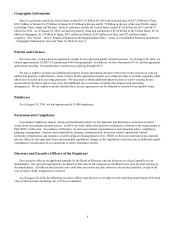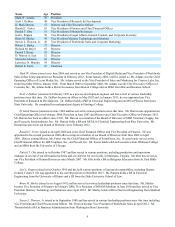Crucial 2014 Annual Report Download - page 20
Download and view the complete annual report
Please find page 20 of the 2014 Crucial annual report below. You can navigate through the pages in the report by either clicking on the pages listed below, or by using the keyword search tool below to find specific information within the annual report.18
The limited availability of raw materials, supplies or capital equipment could materially adversely affect our business,
results of operations or financial condition.
Our operations require raw materials, and in certain cases, third party services, that meet exacting standards. We generally
have multiple sources of supply for our raw materials and services. However, only a limited number of suppliers are capable of
delivering certain raw materials and services that meet our standards. In some cases, materials, components or services are
provided by a single supplier. Various factors could reduce the availability of raw materials or components such as silicon
wafers, controllers, photomasks, chemicals, gases, photoresist, lead frames and molding compound. Shortages may occur from
time to time in the future. We and/or our suppliers could be affected by laws and regulations enacted in response to concerns
regarding climate change, which could increase the cost and limit the supply of our raw materials. In addition, disruptions in
transportation lines could delay our receipt of raw materials. Lead times for the supply of raw materials have been extended in
the past. If our supply of raw materials or services is disrupted or our lead times extended, our business, results of operations or
financial condition could be materially adversely affected.
Our operations are dependent on our ability to procure advanced semiconductor manufacturing equipment that enables the
transition to lower cost manufacturing processes. For certain key types of equipment, including photolithography tools, we are
sometimes dependent on a single supplier. From time to time we have experienced difficulties in obtaining some equipment on
a timely basis due to the supplier's limited capacity. Our inability to timely obtain this equipment could adversely affect our
ability to transition to next generation manufacturing processes and reduce costs. Delays in obtaining equipment could also
impede our ability to ramp production at new facilities and increase our overall costs of the ramp. If we are unable to timely
obtain advanced semiconductor manufacturing equipment, our business, results of operations or financial condition could be
materially adversely affected.
We may incur additional tax expense or become subject to additional tax exposure.
We are subject to income taxes in the United States and numerous foreign jurisdictions, including among others, Singapore,
where we currently have arrangements that allow us to compute our tax provision at rates below the local statutory rates. Our
domestic and international taxes are dependent upon the distribution of our earnings among these different jurisdictions. Our
provision for income taxes and cash tax liabilities in the future could be adversely affected by numerous factors, including
challenges by tax authorities to our tax structure, income before taxes being lower than anticipated in countries with lower
statutory tax rates and higher than anticipated in countries with higher statutory tax rates, changes in the valuation of deferred
tax assets and liabilities and changes in tax laws and regulations. We and our subsidiaries file income tax returns with the U.S.
federal government, various U.S. states and various foreign jurisdictions throughout the world. Our U.S. federal and state tax
returns remain open to examination for 2010 through 2014. In addition, tax returns open to examination in multiple foreign
taxing jurisdictions range from the years 2005 to 2014. The results of audits and examinations of previously filed tax returns
and continuing assessments of our tax exposures may have an adverse effect on our provision for income taxes and cash tax
liability.
We may not utilize all of our net deferred tax assets.
We have substantial deferred tax assets, which include, among others, net operating loss and credit carryforwards. As of
August 28, 2014, our U.S. federal and state net operating loss carryforwards, including uncertain tax benefits, were $3.89
billion and $1.71 billion, respectively, which, if not utilized, will expire at various dates from 2015 through 2033. As
of August 28, 2014, our foreign net operating loss carryforwards were $5.37 billion, including $3.95 billion pertaining to Japan,
which, if not utilized, substantially all will expire at various dates from 2018 through 2023. As of August 28, 2014, we had
valuation allowances of $1.29 billion and $979 million against our net deferred tax assets in the U.S. and Japan, respectively.
A downturn in the worldwide economy may harm our business.
Downturns in the worldwide economy have harmed our business in the past and future downturns could also adversely
affect our business. Adverse economic conditions affect demand for devices that incorporate our products, such as personal
computers, mobile devices, solid-state drives and servers. Reduced demand for these products could result in significant
decreases in our average selling prices and product sales. A deterioration of current conditions in worldwide credit markets
could limit our ability to obtain external financing to fund our operations and capital expenditures. In addition, we may
experience losses on our holdings of cash and investments due to failures of financial institutions and other parties. Difficult
economic conditions may also result in a higher rate of loss on our accounts receivables due to credit defaults. As a result, our
business, results of operations or financial condition could be materially adversely affected.
























